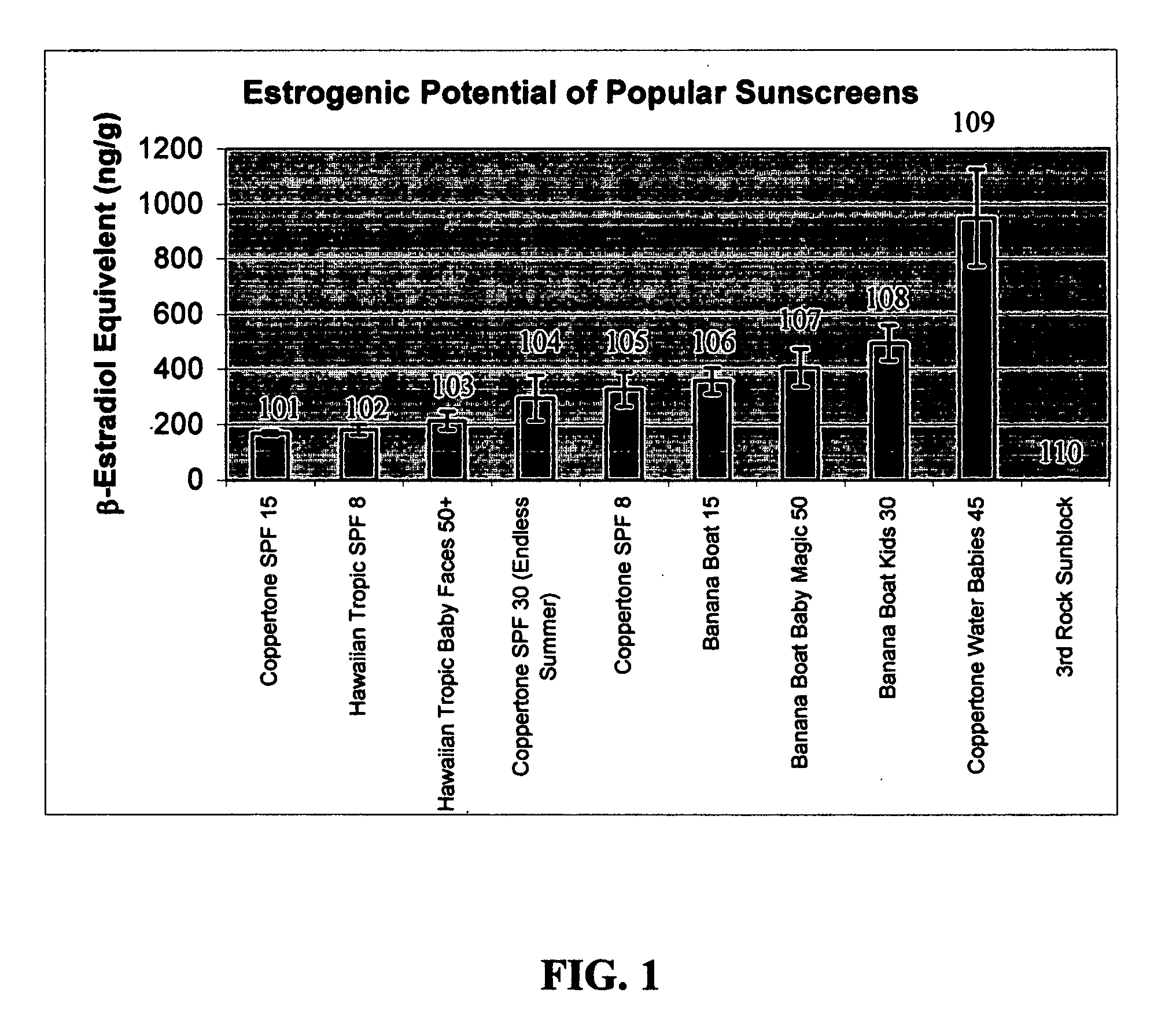Nontoxic, non-endocrine disrupting, cytoprotective, UV-radiation resistant sunblock compositions
a technology of cytoprotective and sunblock, which is applied in the field of ultraviolet radiation protective agents, can solve the problems of unnecessary potential risks to human health (or other mammals), and achieve the effects of avoiding endocrine disrupting agents, enhancing protection, and increasing immuno-responsiveness
- Summary
- Abstract
- Description
- Claims
- Application Information
AI Technical Summary
Benefits of technology
Problems solved by technology
Method used
Image
Examples
example i
[0160] 211.79 ml of deionized water was added to the receptacle. 0.25 grams of xanthan gum was then added to the receptacle. The composition was mixed until free from lumps. 1.0 g of Carrageenan was added to the receptacle. The composition was mixed until free from lumps. The mixture was heated to 80° C. 15.0 grams of vegetable glycerin was then added to the receptacle, along with 15.0 g of Aloe Vera Gel. The ingredients in the receptacle were then mixed until completely uniform. In a second receptacle, 15.0 g of sunflower oil, 30.0 g of phosphatidyl choline, 1.0 g of coconut oil, 80.0 g of carrier oils, 10.0 g of stearic acid, 0.0005 g of beta carotene, 1.0 g of orange wax, 5.0 g of beeswax, and 0.5 g of vitamin E oil (tocopherol) were mixed until all solids were dissolved, and the mixture was heated to 75° C. 5.0 g Crodesta F-160® (produced by Croda USA) was slowly added, while maintaining the temperature at 75° C. 80.0 grams of micronized zinc oxide (Z-cote®) was sprinkled in slo...
example ii
[0162] 139 ml of deionized water was added to the receptacle. 0.91 g of Carrageenan was added to the receptacle. The composition was mixed until free from lumps. The mixture was heated to 80° C. 13.59 grams of vegetable glycerin was then added to the receptacle. The ingredients in the receptacle were then mixed until completely uniform. In a second receptacle, 22.6 g of rice bran oil, 27.18 g of phosphatidyl choline, 36.24 g of carrier oils, 9.06 g of stearic acid, 0.46 g of orange wax, 11.3 g of beeswax, and 0.91 g of vitamin e oil (tocopherol) were mixed until all solids were dissolved, and the mixture was heated to 75° C. 54.41 grams of micronized zinc oxide (Z-cote®) was sprinkled in slowly and homogenized until smooth and uniform. 21.85 grams of micronized titanium dioxide was sprinkled in slowly and homogenized until smooth and uniform. The temperature of this receptacle was increased to 80° C. The first receptacle was then added to the second with vigorous mixing at 80° C. Mi...
example iii
[0164] 139 ml of deionized water was added to the receptacle. 0.91 g of Carrageenan was added to the receptacle. The composition was mixed until free from lumps. The mixture was heated to 80° C. 13.59 grams of vegetable glycerin and 68.0 grams of Aloe Vera gel were then added to the receptacle. The ingredients in the receptacle were then mixed until completely uniform. In a second receptacle, 22.6 g of rice bran oil, 27.18 g of phosphatidyl choline, 36.24 g of carrier oils, 9.06 g of stearic acid, 0.46 g of orange wax, 11.3 g of beeswax, and 0.91 g of vitamin E oil (tocopherol) were mixed until all solids were dissolved, and the mixture was heated to 75° C. 54.41 grams of micronized zinc oxide (Z-Cote®) was sprinkled in slowly and homogenized until smooth and uniform. 21.85 grams of micronized titanium dioxide was sprinkled in slowly and homogenized until smooth and uniform. The temperature of this receptacle was increased to 80° C. The first receptacle was then added to the second ...
PUM
 Login to View More
Login to View More Abstract
Description
Claims
Application Information
 Login to View More
Login to View More - R&D
- Intellectual Property
- Life Sciences
- Materials
- Tech Scout
- Unparalleled Data Quality
- Higher Quality Content
- 60% Fewer Hallucinations
Browse by: Latest US Patents, China's latest patents, Technical Efficacy Thesaurus, Application Domain, Technology Topic, Popular Technical Reports.
© 2025 PatSnap. All rights reserved.Legal|Privacy policy|Modern Slavery Act Transparency Statement|Sitemap|About US| Contact US: help@patsnap.com


